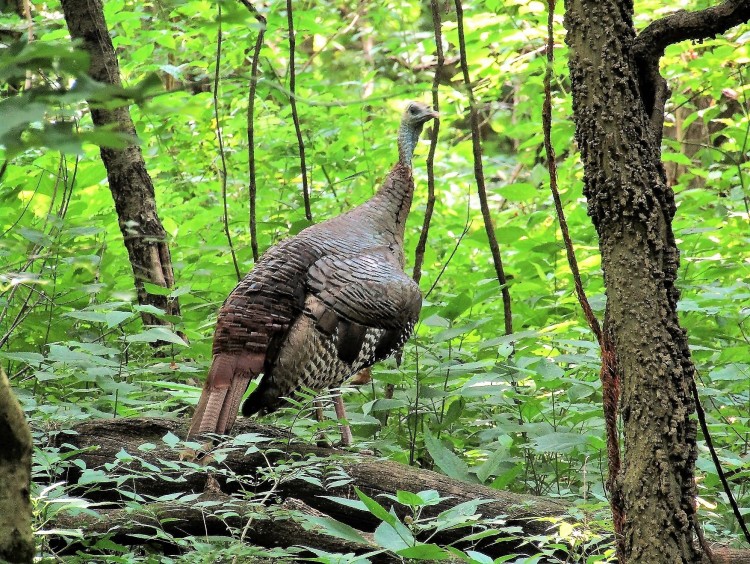
She saw me but she didn’t care. Like much of the forest’s wildlife, this urban bird had apparently decided I was no big threat. Among the dangers she confronts as a large visible fowl, in the city hunting is not one of them. So she could afford to relax a little. From the excellent vantage point of her log, she allowed me to watch her daily grooming ritual – the preen.

First she made a good scan of the surroundings. Despite the turkey jokes, Wild turkeys are very smart, wary animals and can blend into the underbrush instantly when danger threatens. Though she appears to be in deep woods, we were actually quite close to the LNC nature play area, the trail, and a busy neighborhood road. However, the area around her was fairly open, reducing the chances of a predator sneaking up.

Once she began to fluff, I knew what was coming. Living as I do with a flock of free-range parrots, preening is a familiar activity, often performed while sitting on my shoulder. But a turkey preen – such a magnificence of feathers!

The preening ritual is very important to a bird’s survival. Feathers must be kept in prime condition for flight, to shed water, and to preserve warmth in winter. Dirt and parasites are removed, as well as the sheaths surrounding pin feathers. Barbules that have come undone are re-zipped.
In the pic above, she’s getting preen oil from the uropygial gland above her tail, and spreading it over her feathers as waterproofing. Most of her varied feather types are on display – though tom turkeys are considered the “pretty” ones, I think she’s quite a lovely sight.

Birds can reach almost all parts of their bodies with their beaks, but of course not their heads and necks. This is where “allopreening” is useful – having your mate or flock member do that area you can’t get to. It’s a very affectionate bonding behavior, particularly in social species like parrots, or those that cooperate on parenting. Since Wild Turkeys don’t really form pair bonds or raise young together, they don’t allopreen.

She gave herself a good shake and a final fluff, before stepping off the log and vanishing into the undergrowth.
In other turkey news, I have seen very little of the many chicks hatched in spring. It’s unlikely a great number survived – that’s why turkeys lay so many eggs. But a few weeks ago I got to see one youngster flap up into a tree – thereby educating me that young turkeys can fly very well, despite their seeming lack of flight feathers.
I hope it’s a survivor.


Phyllis Fitzgerald
This is a beautiful and instructive post, and the pictures are fabulous. I never understood why they preened for cleanliness; I had thought it was to make themselves more attractive to a potential mate. Thank you for enlightening me with your natural science posts.
LikeLiked by 1 person
oneforestfragment
Thanks Phyllis! I might not have known , but living with birds in the house teaches you a lot.
LikeLike
blissgrey
A lovely site indeed, look at the layers, upon layers of patterns.
LikeLiked by 1 person
Janice
She’s beautiful! And what a lucky sighting of the baby too.
LikeLiked by 1 person
Deany
We were seeing four wild turkeys but now we are only seeing one. The wild turkey is standing near our back gate each morning and late afternoon. When the turkey sees us coming, it walks into the woods. We throw out corn for birds and critters. Once we go back into the yard, closing the gate, the turkey comes back out. We love watching the wild turkey as it walks through the opening. We also can’t believe how fast the turkey can run! Love nature!
LikeLiked by 2 people
shoreacres
I laughed at this: “turkeys are very smart, wary animals and can blend into the underbrush instantly.” I once toured the Konza prairie in Kansas with a friend who’s a docent/volunteer. We came upon some wild turkeys on the road, and I swear I didn’t glance away for more than a nano-second and they just were gone. There’s a favorite old-timey song I love that has a line in the chorus about a man who could be “long gone, like a turkey in the corn.”
I didn’t know the word ‘allopreening,’ but I see the behavior in pigeons, doves, and cardinals. Our water birds, on the other hand, don’t seem to engage in it. There’s nothing funnier than watching a great egret turning itself in a pretzel to get its beak back to that “hard spot” to deal with.
LikeLiked by 1 person
oneforestfragment
I was really surprised that the preening turkey allowed me to watch – urban turkeys are different.
Love that song line too -the old songs and sayings have such sharp observations about the natural world.
LikeLiked by 1 person
Anonymous
Great stuff! Love the photos. I had to look up “barbules”. Didn’t even try w/ the gland word.
LikeLiked by 1 person
oneforestfragment
Thanks! It’s pronounced your-uh-pie-gee-ul, or just call it the preen gland.
LikeLike